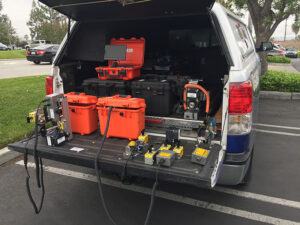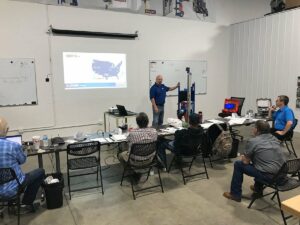Arc Flash Safety Training: Smart Operators Know You’re Never Done
By Justin Gaull, Contributor
 Smart companies know safety training is never complete. Ongoing training and testing are vital to safe, injury-free operations. Proper training (and re-training) on electrical safety equipment and procedures prevents injuries, protects electrical apparatus from damage, and promotes operational efficiencies. Ongoing training is also a requirement to meet code. NFPA 70E, (the standard for electrical safety in the workplace) Article 110, Section6 (3), states that “additional training and retraining in safety-related work practices shall be performed at intervals not to exceed 3 years.”1 The standard also states that training shall be more frequent for certain conditions, including the use of new technology and equipment, procedures performed less than once per year or work practices that are not a normal part of an employee’s regular job duties.
Smart companies know safety training is never complete. Ongoing training and testing are vital to safe, injury-free operations. Proper training (and re-training) on electrical safety equipment and procedures prevents injuries, protects electrical apparatus from damage, and promotes operational efficiencies. Ongoing training is also a requirement to meet code. NFPA 70E, (the standard for electrical safety in the workplace) Article 110, Section6 (3), states that “additional training and retraining in safety-related work practices shall be performed at intervals not to exceed 3 years.”1 The standard also states that training shall be more frequent for certain conditions, including the use of new technology and equipment, procedures performed less than once per year or work practices that are not a normal part of an employee’s regular job duties.
Safety Saves Lives
Electrical safety is no less important than EMT training for saving lives. Imagine if an Emergency Medical Technician didn’t correctly perform CPR or improperly used their AED (Automated Electrical Defibrillator). What if their chest compressions were positioned incorrectly or if AED pads were applied to the wrong locations? Bad news for that patient. But it doesn’t happen because EMTs continuously train – CPR recertification is required every two years for medical practitioners and first responders. Likewise, what if remote racking or remote switching equipment is applied to a breaker incorrectly? Or if a worker doesn’t read the arc flash warning label and adhere to the appropriate PPE category? If there’s an arc flash incident, that’s bad news for everyone in the area. Exposed energized conductors and arc faults can have mortal consequences for workers who don’t follow proper procedures.
With the industry adoption of NFPA 70E, “there has been an annual decrease of 76% in electrical contact fatalities since 1982.” That’s just a few years after the first edition of NFPA 70E.2 The use of electrical-safety procedures, energy-reducing technologies and engineered controls, such as remote switching and racking, reduces electrical injuries from shocks and burns.
 Schedule Training Like You Schedule Maintenance
Schedule Training Like You Schedule Maintenance
Training works, but it doesn’t happen on its own. You need to create and document a safety training schedule for each employee and for your organization as a whole. Then you can execute to the training and retraining schedule just as you would execute to an equipment maintenance schedule. The training becomes part of your standard operating procedures, your employee reviews/evaluations and your culture.
In addition to ongoing retraining, you need to be prepared with a quick-deploy training program for when employees leave your company or move on to new opportunities. Otherwise, you’re left with a dangerous knowledge gap for safe processes and procedures. As a manufacturer of remote switching and remote racking equipment, it’s not uncommon for our team to encounter scenarios where trained personnel leave and there’s inadequate timely training for the new person or team. With that training gap comes an increase in job safety hazards.
Safety Equipment Only Protects when Properly Used
Remote switching or racking equipment can save lives, stave off injury, and prevent an accident from becoming a tragedy – but only when applied and set-up correctly. That’s why training is vital. Workers need to understand and precisely adhere to safe-distance and PPE requirements. They must know how to read arc flash labels and how that information applies to their personal and team safety. They need to understand the correct procedures and sequence to attach and operate safety devices, like remote switching and racking equipment. For example, when using remote racking equipment (in certain applications) on circuit breakers, it’s possible to over-torque a breaker’s racking mechanism during the racking sequence – a risk that can be mitigated with the proper training and equipment application.
Tap into Your Suppliers’ Knowledge Base
A best practice for spot-on training and safe equipment use is to have new employees receive equipment and task training by the OEMs (Original Equipment Manufacturer) of your electrical safety devices. Most manufacturers offer it. We conduct several for our customers each week. Nobody knows the equipment better than the team that designed and built it. Plus, OEMs have already created and fine-tuned training programs that cover all the features and incorporate what they’ve learned through years of conducting trainings. It’s what they do every day.
Effective Training is a Lifelong Process
Just like EMTs who continually train to save lives, electrical workers need ongoing periodic safety training to prevent potentially life-changing events. Fortunately, it’s not difficult to make sure electrical safety knowledge and procedures are refreshed on a regular basis and in accordance with NFPA 70E standards. Create your schedules, conduct the trainings, call in OEMs to help when appropriate – it will become part of your company’s standard procedures and your culture. EMTs save lives after a tragic event. A robust training and retraining program saves lives by preventing tragic events. Train and be a lifesaver. ESW
Justin Gaull is VP of Business Development at CBS ArcSafe. He is a former firefighter/EMT, trained in NFPA 70E, and holds a master’s in technology entrepreneurship from the University of Maryland’s Clark School of Engineering. Learn more at www.groupcbs.com.
Sources:
-
National Fire Prevention Agency. NFPA 70E Handbook for Electrical Safety in the Workplace 2021. 2020
-
Coache, C. Website. (2019, December 04) A Better Understanding of NFPA 70E)org. https://www.nfpa.org/news-and-research/publications-and-media/blogs-landing-page/nfpa-today/blog-posts/2019/12/04/a-better-understanding-of-nfpa-70e-electrical-contact-fatalities
Share on Socials!
Five Ways to Protect Workers During Plant Turn-Around or Shutdowns
NFPA 70B: A Monumental Shift in Electrical Safety
Infrared Technology
Leaders in Electrical Safety
• Aramark
• Bowtie Engineering
• Enespro
• Ericson
• I-Gard Corporation
• IRISS
• KERMEL, INC.
• Lakeland Industries
• MELTRIC Corporation
• National Safety Apparel
• National Technology Transfer
• Oberon
• Saf-T-Gard
• SEAM Group
Subscribe!
Sign up to receive our industry publications for FREE!







